

ClassVR – Virtual Reality for the Classroom. Zspace. Create AR Using These 5 Apps. Looking for a Google Expeditions Replacement? Check Out These 2 AR/VR Tools. Virtual Reality for Education. Bloxels EDU. Curriculum. LEGO Education. RobotLAB- Award Winning Educational Robotics Programs. Robots to code and create with.
Coding Kit for One + Teachers Guide 2021 - Osmo for Schools. Teachers guide. Drones in Education. The book Drones in Education by Chris Carnahan, Laura Zeiger, and Kimberly Crowley was written for educators who want to incorporate drones into their curriculum but have no idea where to start.
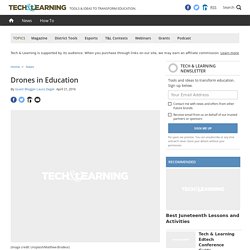
The book was created as drones are being increasingly included in instructional activities providing students with concrete examples of how STEM concepts are applied and utilized in the real world. Even short exposure to robotics can have a lasting impact on students to pursue complex careers that they may have never considered.
This is important as it is projected that the nation will have up to eight million STEM jobs by 2018. In science and engineering classes, students are building drones and writing programs to steer them. Drones Take Their Place in the K–12 Classroom. Photography by: Jeff Nelson In contrast, higher-end drones typically leverage built-in GPS and hover in place when users take their hands off the controllers.

The team’s approach ensures that, as students graduate to more expensive drones, if an aircraft ever loses its GPS signal and starts to fall, students will know how to use the controls to keep it airborne, says Sevits, who saw 100 students enroll in three drone courses this school year. “If something happens when they are flying a $1,500 drone, it’s not as big of a deal. They’ll know what to do,” he says. During the winter months, students fly drones inside the gym and cafeteria. Educational Users. Drones for Education Drones (and model aircraft) are great tools for use in education.
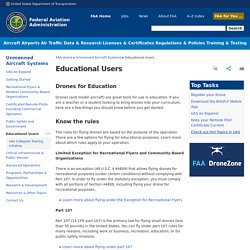
If you are a teacher or a student looking to bring drones into your curriculum, here are a few things you should know before you get started. 7 Best Drones For Education To Build, Learn To Code And Configure - DroneZon. A great educational drone doesn’t cost you a fortune and at the same time gives you everything you need to build and code the UAV.
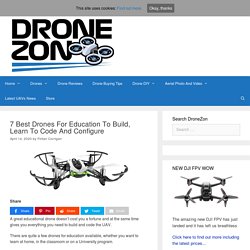
There are quite a few drones for education available, whether you want to learn at home, in the classroom or on a University program. Along with fun learning to build and code, these educational drones are all terrific to fly. Wearable Technology: How Teachers Could Use it with Students - Tech Knowledge. Wearable technology is the latest trend in teaching and learning.
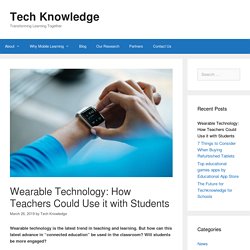
But how can this latest advance in “connected education” be used in the classroom? Will students be more engaged? Wearable technology such as Google Glass is the latest development in teaching and learning. But how will it be used? How wearable technology can personalize physical education. PE teachers are motivating students by personalizing exercise with wearable technology such as Fitbits, Apple Watches and Polar sensors.

Heart healthy—Elementary school students in Washington’s Burlington-Edison School District use armband sensors to track their heart rate during physical education classes so they can maximize their efforts. In an effort to motivate students to improve their health, some physical education teachers now personalize exercise with wearables such as Fitbits, Apple Watches and Polar sensors. “For some students, a wearable piece of technology or interaction with a tablet certainly increases their motivation, and helps them participate in more physical activity,” says Chris Hersl, vice president for programs and professional development for SHAPE America, the Society of Health and Physical Educators.
PE teachers typically purchase a classroom set of fitness wearables that students use during exercise sessions to track the time spent at a target heart rate. Wearable Technology In eLearning: 3 Wearables That Have The Most Potential. With the increase in popularity of wearable technologies like virtual reality and Google Glass headsets and smartwatches, wearable tech has proven to have a place in higher education.
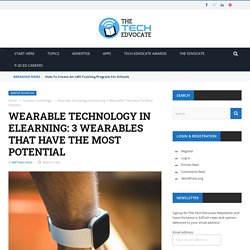
It is transforming how we approach education and is likely to become a core part of the classroom. Once these wearable technologies enter the mainstream, we’re not only going to see them in schools but also in corporate learning and training environments. In this article, we’ll be taking a look at three wearables that have the most potential. Read on for more. Smart Watches. Storytelling With Wearable Technology. Wearable technology is incredibly exciting for educators and students of all ages.

In the past few years, mobile devices have found an essential place in the classroom. If you've used smartphones and tablets as instructional tools, you know how powerful these devices can be in the hands of students. Will this also be true for wearable technology? When we think of wearable technology, products like the Apple Watch and Google Glass might pop into your mind. Wearable devices are increasingly central to a safe return to the classroom. Technology has played a central role during COVID-19, enabling educators to continue teaching remotely, with both students and staff ensconced in the safety of their kitchens or living rooms.
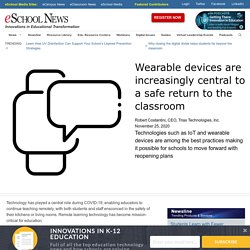
Remote learning technology has become mission-critical for education. But as the pandemic stretches out far longer than we could have imagined, evidence suggests that remote learning is falling short in a number of ways. According to a Wall Street Journal article, approximately 20 percent of students nationwide don’t have access to the technology they need for remote learning. Promoting Active Learning with Fitbits.
Wearable technology is becoming a part of our daily lives.
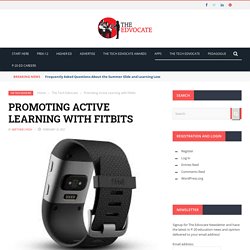
I hardly take a step that is not counted on my Fitbit. This device not only motivates me to move more throughout the day, but it also helps me to be more aware of my health. I monitor my heart rate and sleep patterns, much more than I did before I started using a Fitbit. I have recently been challenging my friends and colleagues to weekly challenges. This has increased my activity level even more. Physical Education & Fitbit: Lessons from Joliet Township High School. When Fitabase first started supporting research studies in 2012, we thought we understood the research landscape and who our customers would be.
Of course, like many companies, we’ve been pleasantly surprised to learn that there are a whole host of other uses for our products. We're constantly impressed by the number of innovative projects, programs, and ideas are out there that include wearable devices and need data management support. Today we want to share one of those unique programs. The Joliet Township High School, located just south of Chicago, IL, is testing the use of Fitbit devices as part of their curriculum-wide Blended Learning program. The Best 3D Printers for 2021. Barely a decade ago, 3D printers were hulking, expensive machines reserved for factories and well-heeled corporations. They were all but unknown outside the small circles of professionals who built and used them. But thanks largely to the RepRap open-source 3D printing movement, these amazing devices have become viable and affordable products for use by designers, engineers, hobbyists, schools, and even curious consumers.
If you're in the market for one, it's important to know how 3D printers differ from one another so you can choose the right model. They come in a variety of styles, and may be optimized for a particular audience or kind of printing. Top 10 Back to School 3D Design Lesson Ideas. 3D Printing for K-12 and Higher Education. Benefits of Using 3D Printers in Modern Learning Environments. Once a novelty in many classrooms and makerspaces, 3D printers are again flourishing as valuable classroom tools thanks to advanced technology, lower costs and more products and services geared toward K–12 education. Both manufacturers and educators are leveraging the benefits of 3D printers in education. 3D modeling and printers can bring almost any educational concept to life, while building practical skills such as problem-solving, creative coding and design.
PRODUCT REVIEW: Dremel DigiLab 3D45 3D printer offers simple and speedy creation. 3D Printing Engages Students. What 3D Printing in the Classroom Means for Education - EdTech Magazine. When Ron Smith first saw a 3D printer in action, he knew the device belonged in his Engineering and Metal Fabrication program at Nestucca Junior/Senior High School in Cloverdale, Ore. The technology could guide students all the way through the manufacturing process — from concept to completion — and reward them with an object they could hold in their hands.
But it wasn’t until Smith had an Afinia 3D printer in his classroom that he realized its value as an educational tool. Computer-assisted design (CAD) software by itself is great, he says. STEM Education and Learning Tools. Pinterest.